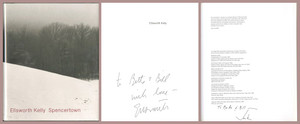
Ellsworth Kelly, Offset lithograph promotional card (hand signed by Ellsworth Kelly), gifted to CBS cameraman with postmarked envelope, 1983
Ellsworth KellyThis is an offset lithograph card hand signed by Ellsworth Kelly on the bottom front
the work depicted in the card is Red over Yellow (Rouge sur Jaune), from Suite of Twenty-Seven Lithographs (A. 19), published by Maeght
This card was acquired from Dan Pope, a longtime CBS photographer and cameraman, who had amassed a superb collection of autographs by visual artists over many decades.
Dan Pope wrote to Ellsworth Kelly at his Spencertown New York residence requesting an autograph, and included a self-addressed stamped envelope for Kelly to return, which was postmarked March 16, 1983 from Albany New York, the nearest major city to Spencertown. The work even includes Kelly's distinctive double signature on his last name - an added special touch.
This work has been elegantly floated and framed in a museum quality wood frame under UV plexiglass. On the back of the frame is the original postmarked self-addressed stamped envelope which Kelly sent to Dan Pope
Measurements:
Framed
13.75 inches vertical by 11.5 inches horizontal by 1.5 inches
Art card:
6.75 inches (vertical) by 3.5 inches (horizontal)
Provenance: Dan Pope of Scarsdale, NY
Ellsworth Kelly Biography:
Ellsworth Kelly’s innovations of the late 1940s and early 1950s helped reshape abstract art for decades. His development of the monochrome and the multi-panel painting, his devotion to integral forms, and his use of chance and seriality would prove central to painting’s break with expressionism in the 1960s. But his approach to abstraction was also utterly unique, grounded in particulars rather than universals. His use of found compositions — the fold of a cigarette packet or the contour of a grape leaf — opened a new horizon of possibilities: “Everywhere I looked, everything I saw became something to be made, and it had to be made exactly as it was, with nothing added.”
Over the course of a seven-decade career, Kelly translated these found compositions into paintings, sculptures, drawings, prints, and photographs whose visual power transcended movements. The consistency of his artistic vision ensured that each work was immediately recognizable as his own, even when he experimented with new forms and materials.
Using the same rigor with which he translated his observations of the world (art historian Richard Shiff has called them “fragments of visual experience”), Kelly often returned to his earlier works and sketches. The immediacy of his sensory intuition, combined with his diligent translation of it, enabled him to keep making innovative work throughout his long career. As John Coplans explained in 1969, “since Kelly rarely abandons an idea — his system is incredibly open — he will permit a nascent or embryonic idea to mature without urgency.” This slow gestation helps explain one of contemporary art’s most consistently surprising bodies of work.
Ellsworth Kelly (1923–2015) was born in Newburgh, New York. In 1948 he moved to France, where he came into contact with a wide range of classical and modern art. He returned to New York in 1954 and two years later had his first exhibition at the Betty Parsons Gallery. The Museum of Modern Art in New York organized his first retrospective in 1973. Subsequent exhibitions have been held at museums around the world, including the Solomon R. Guggenheim Museum in New York, the Tate Gallery in London, Haus der Kunst in Munich, and the Centre Pompidou in Paris.
-Courtesy Matthew Marks Gallery








